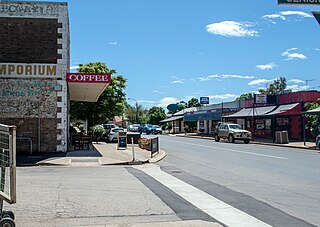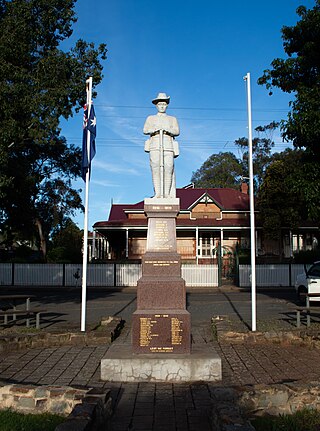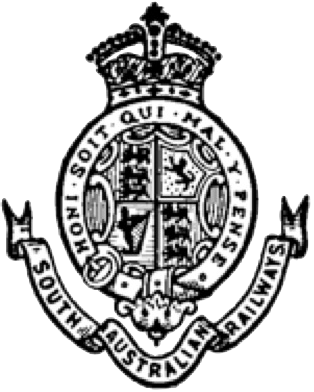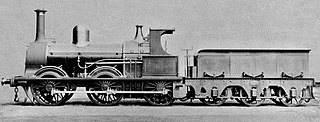
Adelaide railway station is the central terminus of the Adelaide Metro railway system. All lines approach the station from the west, and it is a terminal station with no through lines, with most of the traffic on the metropolitan network either departing or terminating here. It has nine below-ground platforms, all using broad gauge track. The station is located on the north side of North Terrace, west of Parliament House.

Peterborough is a town in the mid north of South Australia, in wheat country, just off the Barrier Highway. At the 2016 census, Peterborough had a population of 1,419. It was originally named Petersburg after the landowner, Peter Doecke, who sold land to create the town. It was one of 69 places in South Australia renamed in 1917 due to anti-German sentiments during World War I.
Australians generally assumed in the 1850s that railways would be built by the private sector. Private companies built railways in the then colonies of Victoria, opened in 1854, and New South Wales, where the company was taken over by the government before completion in 1855, due to bankruptcy. South Australia's railways were government owned from the beginning, including a horse-drawn line opened in 1854 and a steam-powered line opened in 1856. In Victoria, the private railways were soon found not to be financially viable, and existing rail networks and their expansion were taken over by the colony. Government ownership also enabled railways to be built to promote development, even if not apparently viable in strictly financial terms. The railway systems spread from the colonial capitals, except in cases where geography dictated a choice of an alternate port.

The first railway in colonial South Australia was a line from the port of Goolwa on the River Murray to an ocean harbour at Port Elliot, which first operated in December 1853, before its completion in May 1854.

Roseworthy is a small town in South Australia, about 10 km north of Gawler on the Horrocks Highway. At the 2016 census, Roseworthy had a population of 994.

Riverton is a small town in the Mid North of South Australia, in the Gilbert Valley. It is situated on the Gilbert River, from which the town derives its name. Both the Gilbert Valley and Gilbert River were named after the South Australian pioneer Thomas Gilbert. Riverton was first settled in 1856, as a settlement along the bullock track from the mining town of Burra to the capital city Adelaide. It grew from a plan designed by a James Masters who had established the nearby town of Saddleworth. The streets of Riverton received their names chiefly from James Masters and his friends. They commemorate persons notable in the history of the district or the state. At the 2011 census, Riverton had a population of 810. Including the rural areas surrounding the town, the population was 1213.

Tarlee is a town in South Australia. The origin of the name is uncertain, but it is thought to be a corruption of the name Tralee in Ireland. The township of Tarlee was advertised as readied for sale by auction in 1867. Tarlee is in the lower Mid North region where Horrocks Highway crosses the Gilbert River. It is approximately 8 km south of Giles Corner, where the Barrier Highway to Broken Hill diverges from the Horrocks Highway through the Clare Valley. At the 2016 census, Tarlee had a population of 302.

South Australian Railways (SAR) was the statutory corporation through which the Government of South Australia built and operated railways in South Australia from 1854 until March 1978, when its non-urban railways were incorporated into Australian National, and its Adelaide urban lines were transferred to the State Transport Authority.

Saddleworth is a small town in the Mid North region of South Australia. The town is situated on the Gilbert River and along with neighbouring towns of Riverton, Rhynie and Tarlee the local area is known as the Gilbert Valley. The town is bisected by the Barrier Highway. At the 2016 census, Saddleworth had a population of 470.

Hamley Bridge is a community in South Australia located at the junction of the Gilbert and Light rivers, as well as the site of a former railway junction.

The South Australian Railways T class was a class of 4-8-0 steam locomotives operated by the South Australian Railways. Several were sold to the Tasmanian Government Railways; some others operated on the Commonwealth Railways.

The Morgan railway line or North-West Bend railway was a railway line on the South Australian Railways network.

Terowie railway station was located on the Roseworthy–Peterborough line in the South Australian town of Terowie.
The Spalding railway line was a railway line on the South Australian Railways network which branched from the Peterborough line at Riverton and passed through the Clare Valley to Spalding. The line opened from Riverton to Clare on 5 July 1918, being extended to Spalding on 9 January 1922. The cessation of railway services was a consequence of the Ash Wednesday bushfires in February 1983, which caused major damage to infrastructure between Sevenhill and Penwortham. The line was formally closed on 17 April 1984.

The two locomotives comprising the South Australian Railways J class were the only steam locomotives with a 0-6-0 wheel arrangement ever operated by the railway. They went into service in August 1875 and were condemned more than five decades later, in 1932 and 1934.

The South Australian Railways A Class locomotives arrived for the South Australian Railways in September and October 1868 from Robert Stephenson and Company. A third and final locomotive was ordered and arrived in 1873, these locomotives were withdrawn between 1893 and 1924 from the SAR after many years of hard service.

The South Australian Railways H Class locomotives were built by Robert Stephenson and Company in 1870 for the South Australian Railways. The first of three numbered 25, 26 and 27 were all in service by June 1871. After being a well received class, two more locomotives were ordered and were in service by October 1872. Nos. 30 and 31 arrived in August 1874. The final two locomotives ordered for the SAR arrived in August 1877 and were numbered 2 and 3. These locomotives worked on the SAR system for many years, with only one member of the class being withdrawn in 1888. The rest of the class were rebuilt over the years and lasted well into the next century with, the final locomotive being withdrawn by 1930.

Four South Australian Railways L class broad-gauge locomotives with a 4-4-0 wheel arrangement were built by Beyer, Peacock and Company in 1879 and entered service in March–April 1880. They were condemned in 1928 and 1931, and were subsequently scrapped.
















